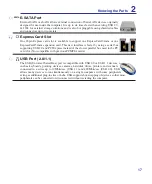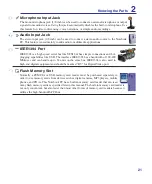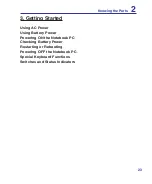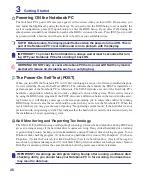
26
3
Getting Started
IMPORTANT! If warnings are still given during bootup after running a software disk
checking utility, you should take your Notebook PC in for servicing. Continued use
may result in data loss.
IMPORTANT! To protect the hard disk drive, always wait at least 5 seconds after turn-
ing OFF your Notebook PC before turning it back ON.
NOTE: Before bootup, the display panel flashes when the power is turned ON. This is
part of the Notebook PC’s test routine and is not a problem with the display.
WARNING! DO NOT carry or cover a Notebook PC that is powered ON with any materi-
als that will reduce air circulation such as a carrying bag.
Powering ON the Notebook PC
The Notebook PC’s power-ON message appears on the screen when you turn it ON. If necessary, you
may adjust the brightness by using the hot keys. If you need to run the BIOS Setup to set or modify the
system configuration, press [F2] upon bootup to enter the BIOS Setup. If you press [Tab] during the
splash screen, standard boot information such as the BIOS version can be seen. Press [ESC] and you will
be presented with a boot menu with selections to boot from your available drives.
The Power-On Self Test (POST)
When you turn ON the Notebook PC, it will first run through a series of software-controlled diagnos
-
tic tests called the Power-On Self Test (POST). The software that controls the POST is installed as a
permanent part of the Notebook PC’s architecture. The POST includes a record of the Notebook PC’s
hardware configuration, which is used to make a diagnostic check of the system. This record is created
by using the BIOS Setup program. If the POST discovers a difference between the record and the exist-
ing hardware, it will display a message on the screen prompting you to correct the conflict by running
BIOS Setup. In most cases the record should be correct when you receive the Notebook PC. When the
test is finished, you may get a message reporting “No operating system found” if the hard disk was not
preloaded with an operating system. This indicates that the hard disk is correctly detected and ready for
the installation of a new operating system.
Self Monitoring and Reporting Technology
The S.M.A.R.T. (Self Monitoring and Reporting Technology) checks the hard disk drive during POST and
gives a warning message if the hard disk drive requires servicing. If any critical hard disk drive warning
is given during bootup, backup your data immediately and run Windows disk checking program. To run
Window’s disk checking program: (1) right-click any hard disk drive icon in “My Computer”, (2) choose
Properties, (3) click the Tools tab, (4) click Check Now, (5) select a hard disk drive, (6) select Thorough to
also check for physical damages, and (7) click Start. Third party disk utilities such as Symantec’s Norton
Disk Doctor can also perform the same functions but with greater ease and more features.
Содержание Z84J
Страница 1: ...Notebook PC Hardware User s Manual E2925 Nov 2006 ...
Страница 4: ... Contents ...
Страница 10: ...10 1 Introducing the Notebook PC ...
Страница 22: ...22 2 Knowing the Parts ...
Страница 52: ...52 4 Using the Notebook PC ...
















































